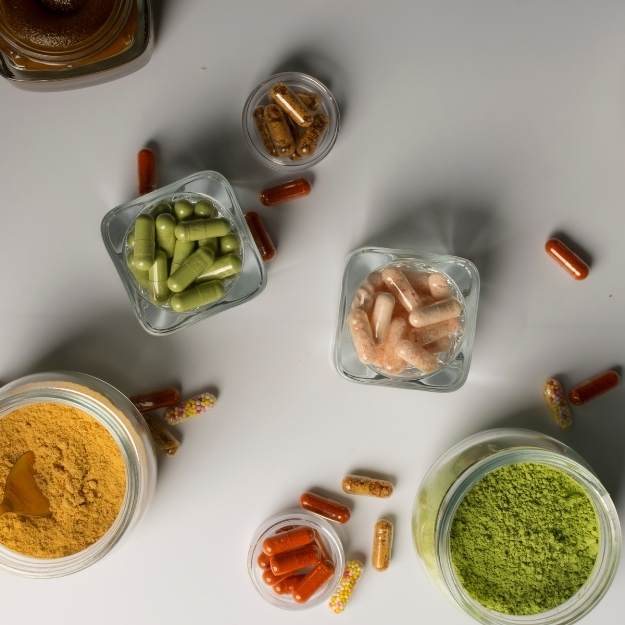
Laboratory check-up and diagnostics: Essential trace elements and micronutrients to support school, sports, dancing, and the daily challenges of everyday life.
Nourished from head to toe: How micronutrients and essential building blocks promote the development of children and adolescents
In order to optimally support these changes, an adequate supply of micronutrients is essential.
Adolescence is a period of transition and development—not only emotionally and socially, but also physically. During this phase of life, characterized by growth spurts, hormonal changes, and the development of cognitive and social skills, the demands on the body increase dramatically. To optimally support these changes, an adequate supply of micronutrients is essential.
Vitamins, minerals, and other essential nutrients contribute to strengthening the growing body, supporting the immune system, and promoting cognitive development. However, despite the diverse food offerings in countries like Germany, it is clear that many young people do not reach the recommended nutrient intake. Particularly alarming are the results of the National Food Consumption Study II, which demonstrate that a large proportion of young people do not consume enough fruit and vegetables, leading to a deficiency in important micronutrients.
In addition, today's adolescents suffer from significant stress that affects nutrient supply and utilization. Stress, whether caused by academic demands, social media, pressure to perform, or personal challenges, can further increase micronutrient requirements. Chronic stress impairs metabolism, weakens the immune system, and can have long-term health consequences. This represents a serious problem, especially in a phase of life in which growth and development are so crucial.
Environmental and agricultural problems
Intensive soil cultivation has led to a decline in the vitamin and mineral content of many foods in recent decades. Our soils are becoming increasingly depleted, meaning that even an otherwise balanced diet often fails to provide all the necessary micronutrients.
Particularly critical in Germany is the fact that we live in a region low in selenium and iodine. Selenium and iodine are essential trace elements that are vital for thyroid function, cell protection, and the immune system. However, the natural conditions for an adequate supply are not present in many regions of Germany. Even with healthy foods, it can therefore be difficult to meet the needs of these micronutrients.
The following sections highlight the importance of individual vitamins and minerals during adolescence, show how these needs can be optimally met, and explain why a balanced diet is essential during this sensitive developmental phase. The challenges posed by stress, environmental influences, and modern eating habits are also addressed. The goal is to raise awareness of the essential role of a healthy diet among adolescents and to sensitize parents, teachers, and young people themselves to this important topic.

Micronutrients and their importance for brain development and cognitive performance in children
Micronutrients play a crucial role in the metabolism and health of the human body. They are particularly important for brain development and function. This applies to all stages of life, with the developing organism being particularly sensitive to deficiencies. Micronutrient deficiencies can be problematic at any stage of life, but the consequences are particularly severe during certain developmental windows.
The 1000-day window: critical phase of brain development
The human brain grows most rapidly from the last third of pregnancy to the end of the second year, a period known as the "1,000-day window." During this phase, the focus is on the growth of dendrites (branching of nerve cells) and the formation of synapses (connections between nerve cells). Adequate availability of specific micronutrients such as iron, vitamin B12, vitamin D, and iodine, to name a few, is essential for these processes.
A deficiency during this phase inevitably leads to structural developmental disorders of the brain. The resulting cognitive deficits are often irreversible and can persist for life. These deficits impair a person's academic performance, later professional development, and quality of life.
Continued brain development into young adulthood
Brain development doesn't end with the second year of life, but continues into early adulthood. One of the brain regions that takes the longest to mature is the frontal lobe. This area is responsible for higher cognitive functions such as planning, problem-solving, decision-making, and strategic thinking.
Temporal focal points of frontal brain development are:
-
Birth to the second year of life : critical phase of basic structuring.
-
Seventh to ninth year of life : Important phase for the development of cognitive abilities and social skills.
-
Middle teens : Refining of frontal lobe functions.
Micronutrient deficiencies during these phases can impair cognitive development and negatively impact both academic and social skills.
Micronutrient deficiencies in children and adolescents in Germany
Despite the wide range of food available in Germany, it is clear that young people are often inadequately supplied with micronutrients. The results are alarming:
-
Vitamin D : Over 90% of adolescents do not meet their recommended intake. Vitamin D is important for neuronal function and overall health.
-
Vitamins B1 and B2 : Around 20% of young people do not get enough of these vitamins, which are essential for the energy supply of brain cells.
-
Folic acid : About 70% of adolescents are deficient. Folic acid is important for DNA synthesis and cell division, which are essential for the developing brain.
-
Vitamin B12 : One-third of adolescent girls are deficient, which can impair the formation of the myelin sheath around nerve cells and cognitive performance.
-
Vitamin C : 30% of adolescents do not reach the recommended amounts. Vitamin C plays a role in antioxidant protection and neurotransmitter synthesis.
-
Iron : Girls are particularly affected, with 76% of them having deficiencies. Iron is crucial for oxygen transport and energy supply to the brain.
-
Zinc : Almost 30% of adolescents have insufficient zinc intake. Zinc is an essential factor for cell growth and neuronal communication.
Consequences and countermeasures – Your Ory team recommends:
The consequences of these deficiencies are diverse. They range from impaired concentration and learning ability to long-term impairments in cognitive development and mental health. The following measures are crucial to preventing these problems:
-
Nutritional advice : Schools and families should be better informed about the importance of a balanced diet.
-
Food fortification : As is already common practice in many countries, fortification of staple foods with important micronutrients (e.g. iodine in salt, folic acid in flour) could improve the supply situation.
-
Supplementation : In cases of proven deficiencies, targeted dietary supplements can be a useful solution.
-
Regular examinations : Pediatricians should pay more attention to micronutrient intake and recommend regular blood tests.

Amino acids: key building blocks for brain development in children
Amino acids play a central role in the physical and mental development of infants and young children. Adequate availability of these building blocks is essential, especially in the first years of life, when growth and brain development are at their peak.
Amino acids: Why they are so important
The amino acid requirement of infants and young children, relative to their body weight, is significantly higher than that of older children or adults. However, some amino acids that are considered non-essential for adults are indispensable for infants. This is because the body is not yet able to produce certain amino acids in sufficient quantities during this early stage of life.
Taurine: An essential nutrient for the brain
Taurine is particularly important for the brain development of fetuses and newborns:
-
Essential for infants : A newborn's body cannot yet produce taurine from sulfur-containing precursors. Therefore, it must be obtained through the diet.
-
Importance for brain development : Taurine plays an important role in the growth of neuron precursor cells and contributes to the development of nerve cells.
-
High concentrations in newborns : The taurine concentration in the blood of newborns is three to five times higher than that of the mother. This demonstrates the importance of taurine during this period.
-
Important function for the retina : Taurine also supports the development of nerve cells in the retina and thus contributes to visual development.
Amino acids and brain metabolism
Some amino acids have a direct influence on brain metabolism and the function of the nervous system:
-
Tryptophan : This amino acid is the basis for the formation of the neurotransmitter serotonin , which is important for the regulation of mood and social behavior.
-
Tyrosine : Tyrosine is needed for the production of catecholamines such as dopamine and noradrenaline, which promote motivation, attention and concentration.
-
Serine : Serine is a starting substance for the formation of choline and phosphatidylserine , which are essential components of cell membranes and myelin (protective sheath of nerve cells).
-
Glutamic acid : Initial evidence suggests that supplementation with glutamic acid may be beneficial for children with concentration problems.
Amino acids are essential for the healthy development of the body and brain, especially in the early years of life. They support brain maturation, mood, social behavior, and the ability to concentrate. Taurine stands out due to its special role in brain and retinal development. A balanced diet containing all essential amino acids is therefore of utmost importance, especially in early childhood. In special cases, targeted amino acid supplements can be helpful to further support development.
Compensating for iron deficiency in adolescent girls
How iron works
Iron is an essential micronutrient that performs numerous vital functions in the body. It is indispensable for oxygen transport in the blood, energy production, and blood formation. The need for iron increases significantly, especially during adolescence, a time of intensive growth and hormonal changes.
Iron deficiency can have serious consequences. It often leads to anemia, a condition in which the oxygen supply to cells is restricted. It is estimated that one in four people worldwide is affected by anemia, with about half of these cases being due to inadequate iron intake.
The symptoms of iron deficiency can be varied:
-
Fatigue and reduced performance
-
Difficulty concentrating or learning
-
Hair loss
-
brittle nails
-
in severe cases, limited physical capacity
Adolescent girls are particularly at risk from iron loss during menstruation. An average of 0.5 milligrams of iron are lost per milliliter of blood. If the diet doesn't compensate for this loss, a deficiency can quickly develop.
Why adolescent girls are particularly at risk
Three-quarters of young women in Germany do not reach the recommended daily iron intake of 15 milligrams. This requirement increases significantly, especially during adolescence, when the body grows and menstruation begins. Intense physical activity, which many young people engage in, can also further increase the need for iron.
Inadequate iron intake during this phase not only impairs physical performance, but also mental well-being and the ability to concentrate. Adolescents suffering from iron deficiency often report fatigue, school problems, and general lack of energy.
Studies on iron deficiency and supplementation
Studies show that daily iron supplementation can have positive effects on adolescents suffering from iron deficiency:
-
Reduction of tiredness and general exhaustion
-
Improvement of physical performance
-
Strengthening blood formation to avoid anemia
Whether iron supplementation also improves cognitive performance requires further research. Nevertheless, adequate iron intake is essential to optimally support growth and development processes.
Iron: Dosage and recommended intake
For optimal supply, micronutrient experts recommend a daily supplement:
-
Young men : 2 to 4 milligrams of iron,
-
Young women : up to 7 milligrams of iron per day.
This amount covers about one-third to one-half of the recommended daily intake (young men: 12 milligrams; young women: 15 milligrams). The remaining requirement should ideally be met through iron-rich foods, such as:
-
Meat and offal (e.g. liver)
-
Legumes (e.g. lentils and chickpeas)
-
green leafy vegetables (e.g. spinach and kale)
-
Whole grain products (in moderation, due to their phytate content)
Optimal absorption of iron
To ensure proper absorption of iron, it should not be consumed simultaneously with "iron thieves." These substances inhibit iron absorption in the intestine:
-
Coffee and tea (due to tannins),
-
Milk and dairy products (due to their high calcium content)
-
Cola and soft drinks (because of the phosphates they contain)
-
Whole grain products (due to phytic acid)
Instead, it is recommended to combine iron-rich foods with products containing vitamin C, as vitamin C promotes iron absorption. Good sources of vitamin C include:
-
Citrus fruits
-
paprika
-
broccoli
-
Sea buckthorn
For best tolerability, iron should be taken with a meal. This reduces potential side effects such as stomach upset.

Vitamin C and zinc: For a strong immune system and beautiful skin
How vitamin C and zinc work
Vitamin C and zinc are essential micronutrients responsible for numerous processes in the body. Adequate intake of these substances is particularly important for adolescents, whose bodies are undergoing a phase of growth and development.
1. Support of the immune system
-
Vitamin C : It attracts messenger substances that activate the immune system and contributes to the function of white blood cells, which are crucial for fighting infections. It also strengthens the barrier function of the skin and mucous membranes, helping to prevent pathogens from entering. Studies show that vitamin C and zinc can shorten the duration of colds.
-
Zinc : This micronutrient plays a key role in cell division and immune defense. It promotes the regeneration and activity of immune cells. Zinc also has anti-inflammatory properties.
2. Protection against oxidative stress
Both micronutrients act as antioxidants by scavenging free radicals that can damage cells and cause oxidative stress. Oxidative stress is linked to numerous diseases, such as chronic inflammation and age-related diseases. Through their antioxidant effects, vitamin C and zinc protect the body's cells and contribute to improved health.
3. Strengthening of skin and connective tissue
Vitamin C and zinc play a central role in the formation of collagen, an important protein that maintains the structure of connective tissue.
-
Vitamin C : Supports collagen synthesis and promotes firm tissue and healthy skin. It also strengthens the skin's barrier function, counteracting skin problems.
-
Zinc : Zinc has antibacterial properties and regulates sebum production, making it particularly valuable for adolescents with acne. Studies show that adequate zinc intake reduces inflammation and minimizes skin blemishes such as papules and pustules.
Vitamin C and zinc: dosage and recommended intake
The following daily recommendations apply to adolescents:
-
Vitamin C : According to the German Nutrition Society (DGE), the daily requirement is 85 milligrams . A supplement of 50 to 80 milligrams per day is recommended for supplementation.
-
Zinc : The daily requirement is 11 milligrams for boys and 14 milligrams for girls. Micronutrient experts recommend a supplement of 5 to 10 milligrams to ensure optimal intake.
Instructions for use :
-
Preparations should ideally be taken with a meal to improve tolerability.
-
Foods containing vitamin C such as citrus fruits, peppers or broccoli promote zinc absorption.
Important information about zinc
In certain conditions, such as chronic kidney failure, supplemental zinc intake should be avoided. Weakened kidneys cannot excrete zinc effectively, which could lead to a dangerous accumulation in the blood. In such cases, supplementation should only be undertaken after consulting a physician.
Vitamin C and zinc are essential for a strong immune system and healthy skin. They boost the body's defenses, protect cells from oxidative stress, and contribute to the formation of collagen, which keeps skin firm and healthy. Adolescents, in particular, should ensure adequate intake, as their growing bodies depend on these micronutrients. A combination of a balanced diet and, if necessary, targeted supplementation can optimally meet these needs to promote health and well-being.
B vitamins: Essential for healthy cells and well-being
The importance of B vitamins
B vitamins are truly multitalented and play a key role in the body's health and growth. They support cell division, which is particularly important in rapidly renewing tissues such as skin, hair, or intestinal mucosa. They also ensure that the body can extract energy from food—an essential function, especially during growth phases.
Another key aspect is the involvement of B vitamins in the breakdown of homocysteine , a metabolic byproduct that, in high concentrations, can damage cells and increase the risk of cardiovascular disease. A well-functioning metabolism, supported by sufficient B vitamins, helps detoxify homocysteine and keep the body healthy.
Why adolescents often do not consume enough B vitamins
Unfortunately, it appears that many young people are not getting enough B vitamins. The deficiency is particularly pronounced in folic acid :
-
Four out of five young men do not reach the recommended daily intake of 300 micrograms.
-
The figures are even more alarming for young women – less than 14% consume enough folic acid.
Girls taking the contraceptive pill should pay particular attention to ensuring they have an adequate supply. Studies involving over 4,000 participants have shown that the pill can lower blood folic acid levels. This is due to reduced absorption in the intestines and increased excretion via the kidneys. Many adolescents also lack sufficient levels of other B vitamins, such as vitamins B2, B6, and B12 . However, these vitamins are crucial for metabolism and overall health.
How can you meet your B vitamin needs?
To ensure adequate intake, micronutrient experts often recommend taking a combination supplement containing all B vitamins. Particular attention is paid to folic acid, as this vitamin is particularly often deficient. The best option is 5-methyltetrahydrofolate , a form of folic acid that the body can use directly.
Recommended dosages :
-
Folic acid : 150 to 300 micrograms daily
-
Vitamin B1, B2, B6 : 1 to 2 milligrams each daily
-
Vitamin B12 : 2 to 4 micrograms daily (as methylcobalamin)
Ideally, they should be taken with meals, as this allows the vitamins to be better tolerated and optimally absorbed by the body.
Why good care is important
A sufficient intake of B vitamins not only ensures healthy cells but also contributes to a smooth metabolism. They promote concentration, energy production, and regeneration. At the same time, they help protect the body from the negative effects of excess homocysteine and support skin, hair, and nails. Adolescents during growth and development phases especially benefit from a targeted supply of these vitamins.
A conscious approach to nutrition and, if necessary, supplementation with high-quality preparations contribute to strengthening health in the long term and creating the basis for well-being and vitality.

Iodine: Indispensable for the thyroid and metabolism
Why iodine is so important
Iodine is an essential trace element that the body needs for thyroid function. The thyroid is often referred to as the body's "gas pedal" because it controls various metabolic functions, growth, and energy production. Iodine is the main component of thyroid hormones, which are involved in virtually all bodily processes.
Iodine deficiency can have serious consequences: It often leads to an underactive thyroid, which slows metabolism, limits performance, and can impair growth. Adequate iodine intake is particularly crucial during adolescence, a time of rapid growth and hormonal changes.
Iodine deficiency in Germany
In Germany, iodine deficiency is widespread due to the low iodine content of the soil. For this reason, Germany is classified as an iodine-deficient area . To improve the supply, table salt has been fortified with iodine, which has led to an improvement. However, experts warn that many people's iodine intake is still inadequate.
The recommended daily intake is:
-
150 micrograms for women,
-
200 micrograms for men.
However, many people don't achieve these levels through diet alone. Therefore, it's important to pay particular attention to adequate iodine intake—especially for adolescents who are growing and have an increased need.
How can iodine requirements be met?
To meet daily requirements, micronutrient experts recommend a daily supplement of 60 to 80 micrograms of iodine for adolescents. Iodine supplements, such as tablets or capsules, are a good way to ensure adequate intake. They should ideally be taken with a meal to improve tolerance.
Additionally, iodine-rich foods such as fish, seafood, and dairy products should be included in your diet. Iodized table salt can also help improve your intake.
Important information about iodine
In cases of certain thyroid disorders, such as hyperthyroidism or the autoimmune disease Hashimoto's thyroiditis , iodine intake should only be undertaken after consulting a physician . While those affected also need iodine, excessive intake can negatively impact the course of the disease. A physician can determine individual needs and recommend an appropriate dosage.
Iodine is an essential nutrient for the thyroid and the entire metabolism. Adequate supply is essential for growth, energy production, and well-being – especially during adolescence. Since the natural iodine supply in Germany is often inadequate, dietary supplements can help compensate for deficiencies. At the same time, iodine-rich foods should be incorporated into the diet.
Studies and data show that a purely diet-based diet is insufficient for many adolescents to provide all essential nutrients in the necessary amounts. Even with a healthy diet rich in fresh fruits, vegetables, and other healthy foods, gaps in nutrient intake often remain.
The reasons for this are manifold :
-
Poor eating habits (e.g. too little fruit and vegetables)
-
stress
-
increased need due to sport
-
Inflammation (in the gastrointestinal tract)
-
Increased need during growth and hormonal changes
-
Environmental factors such as iodine-poor soils that limit natural nutrient supply
Therefore, it's important to specifically look for deficiencies. This can be done through blood tests or other diagnostic procedures that reveal individual deficiencies. If deficiencies are identified, they can be corrected with targeted nutritional supplements.
The effect of subclinical thiamine deficiency in toddlers on motor skills in preschool children
https://pubmed.ncbi.nlm.nih.gov/28133900/
Vitamin B12 deficiency in children is associated with grade repetition
https://pubmed.ncbi.nlm.nih.gov/25972530/
Nutritional status and performance in the test of verbal and nonverbal intelligence in 6-year-old children
https://www.sciencedirect.com/science/article/abs/pii/S0160289605000863
Vitamin D in adolescence: evidence-based nutritional needs
https://pubmed.ncbi.nlm.nih.gov/29198201/
Maternal selenium deficiency during pregnancy is associated with autism and ADHD traits in children
https://pubmed.ncbi.nlm.nih.gov/38704054/
Serum selenium, selenoprotein P and glutathione peroxidase 3 during early and late pregnancy
https://pubmed.ncbi.nlm.nih.gov/37813341/
The adverse effects of mild to moderate iodine deficiency during pregnancy and childhood
https://pubmed.ncbi.nlm.nih.gov/17956157/
The influence of dietary components on the symptoms of ADHD in children
https://pubmed.ncbi.nlm.nih.gov/22928358/
The role of zinc in the treatment of hyperactivity disorder in children
https://pubmed.ncbi.nlm.nih.gov/20034331/
Iodine supply in Germany: Results of iodine monitoring in children, adolescents and adults
https://www.bmel.de/DE/themen/ernaehrung/gesunde-ernaehrung/degs-jod-studie.html



Share:
Black seed oil: A versatile natural remedy and its health benefits
Omega-3 fatty acids, especially eicosapentaenoic acid (EPA) and docosahexaenoic acid (DHA), offer several health benefits